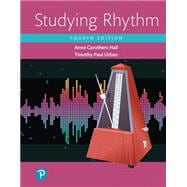For courses in Music Theory, Musical Skills, or Sight Singing.
A thorough, practical introduction to rhythm
Studying Rhythm introduces students to the basic processes and complexities of musical rhythm and helps them develop the ability to perform all kinds of rhythmic patterns accurately at sight. Authors Anne Hall and Timothy Urban provide students over 300 one- and two-part rhythmic studies, each with short preliminary exercises, that are intended to be sung, spoken, and tapped or clapped. The Fourth Edition offers fresh examples from the standard repertory as well as new material on structured improvisation.










